WWI pilot's 14k gold Deutsche Präzisions-Uhrenfabrik Original Glashütte watch
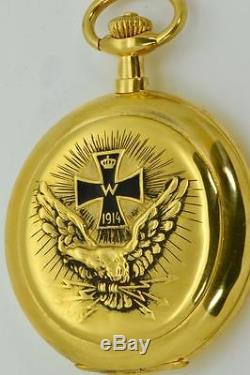
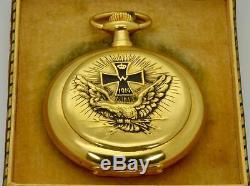
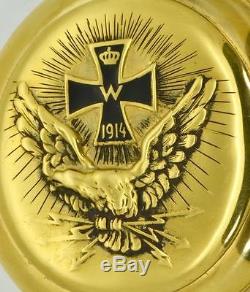
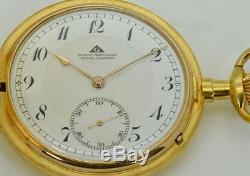
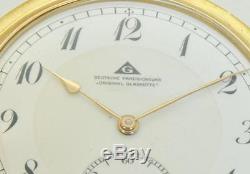
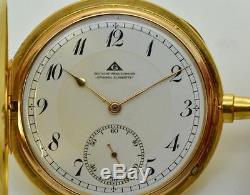
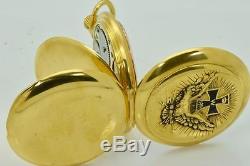
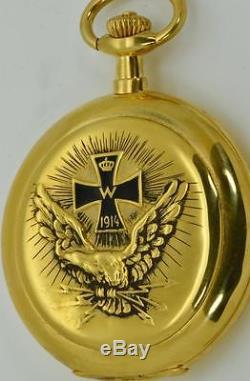
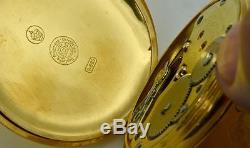
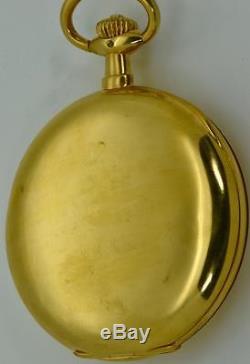
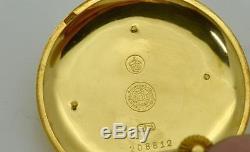


WWI pilot's 14k gold Deutsche Präzisions-Uhrenfabrik "Original Glashütte" watch. Lange&Sohne caliber 14k gold&enamel full hunter case pocket watch in luxury presentation box. This rare watch has been awarded to the German Ace Otto Fruhner for Bravery. Otto Fruhner (6 September 1893 19 June 1965). He was one of the first aviators to. Beginning as a lowly enlisted mechanic in late 1914, Fruhner rose into the officer's ranks. He was eligible for Germany's highest officer's decoration for valor, the. S abdication scotched the award and the German military largely disbanded after its defeat. Fruhner would return to his nation's service to join the nascent. He would serve in various training commands throughout World War II, rising to become a Generalmajor. The watch looks in the same way like in the day it left the factory! The watch has an amazing full hunter solid gold case(the inner cuvette case is also solid gold). The front cover depicting the WWI. Luftstreitkräfte (Imperial German Air Service) black enamel badge. The watch is top qualty A1 grade lever chronometer-one of the most accuarate mechanical time keeper ever created!
This legendary 3/4 plate movement(invented by Adolph Lange for better stability of the watch) is 23kt goldplated, all hand finished, blue steel screwsuntouched by human hand! , precision swan neck micrometric regulator, blue Breguet hairspring, the winding wheels are polished in a special spiral decoration, the balance wheel is fited with gold compensateing weights, old style hand engraved balance cock, central Chaton(the ruby mounted in gold screw settings), gold escape wheel, single banking pin with a chaton endstone. The movement is numbered and signed. Outstanding enamel dial with gold hands.
The watch is in perfect working order-keeping exact time. The watch is very impressive-102g heavy in 14k solid gold!!! The Glashutte watches are most highly priced in the German auctions.
The History of Glashütte Original. In 1845, Ferdinand Adolph Lange began the first watch company in the German silver mining town of Glashütte with a loan from the Saxon government. He intended to start an independent Saxon watchmaking industry in Germany and particularly Glashütte.
With Lange' boosterism and success, by the 1850's some of the greatest master watchmakers were drawn to Glashütte, such as Adolph Schneider, Moritz Grossmann, and Julius Assmann, whose German Precision Pocket Watch Factory won international prizes. By 1865, the typical precision pocket watches made in Glashütte had tremendously advanced, with inventions such as the Glashütte three-quarter plate, gold lever wheels and chatons, and a sunburst finish on the case.
This style was the standard for eight decades. Also well appreciated were the Glashütte pendulum clocks, notably those made by Ludwig Strasser and Gustav Rohde in the Strasser & Rohde Mechanical Workshops, founded in 1877. Their precision pendulum clocks were utilized in institutes, observatories, and other watch companies to accurately synchronize marine chronometers and pocket watches. Strasser also achieved importance as a teacher and ultimately the director of the Glashütte German School of Watchmaking, opened on May 1, 1878, by Moritz Grossmann and the Central Association of German Watchmakers. Teachers at the school such as the dynamic and brilliant Alfred Helwig began training some of the finest watchmakers in the world to fill the growing demand for qualified craftspeople (Since 2002, Glashütte Original has had its own watchmaking school named after Helwig). As early as 1916 Karl W. Hohnel marked one of his pendulum clocks for the first time with the words, Original Glashütte. The German Precision Watch Factory Glashütte Sa. In 1921, Alfred Helwig developed the flying tourbillon, bringing wide acclaim for him and to the school. His tourbillon appeared to "fly" because it was only attached on one side with twin bearings guiding the wheel staff.This allowed the escapement and tourbillon to be attached without a top cock so the tourbillon appeared to fly. With less pressure on it, the mechanism produced the best rate precision of any portable watch.
In 1926, to meet growing demands for wristwatch movement blanks, a new company was founded in Glashütte called UROFA, an offshoot of the Glashütte Precision Watch Factory. UFAG, another new company, finished and distributed the watches. In 1927, a ladies watch was produced with "Glashütte Original" imprinted on the dial for the first time. On July 1st, 1952, the public company, Glashütte Watch Factories, was created from a merger of eight local firms.
These included UFAG, UROFA, VEB Lane formerly A. Lange & Sohne, VEB Estler, VEB Feinterchnik, VEB Prasision Glahsütte, and the Makarenko trade school.
One of the initial creations was the chronograph movement 64, originally the UROFA caliber 59. In the 1960'' Glashütte produced elegantly designed, durable timepieces made for constant daily use. Men and women' wrist watches were created with shock resistance, date display, sweep seconds, automatic winding, and above all, improved accuracy. The Glashütte reputation began to soar in Europe. In the early 60', the caliber 70 series mechanisms were produced, including the caliber 70.1 and 70.3, which included a gilded balance rim and came with a chronometer test certificate. In the mid 60' the "Spezimatic" movements were debuted. The caliber 74 was automatic, and the caliber 75 was automatic with a date. The movement was diminutive in profile at 4.4 mm. High and a diameter of only 28 mm. The "Spezichron" watch arrived in 1978, with a date display and the day of the week moved by a ball bearing mounted rotor.It was produced into the mid 1980'. The 70' saw the rise and worldwide Japanese invasion of the quartz watch; despite the dizzying demand, the Glashütte watchmakers refused to convert their whole production to this enormous change. But they did make some wonderful contributions to the technology with the first quartz-powered marine chronometers. Glashütte had been known for years for its classic marine chronometers; by 1978 over 13,000 had been made, and the caliber 31 created a new era for quartz wristwatches.
They were particularly well suited for ladies watches because the mechanisms were smaller. Glashütte also made a two-hand/analogue-digital quartz movement for men in the 1980'. In 1990, after the reunification of Germany, the company officially became Glashütter Uhrenbetrieb GmbH. It became the legal commercial heir to every former independent watchmaker in Glashütte as far back as 1951.The brand name officially became Glashütte Original in 1994, already a hallmark of precise German horology. At the turn of the new millennium, Glashütte Original received the "Watch of the Year" honor in Germany for its Senator Perpetual Calendar (100-02-25-05-05) in 2000. Acquired the manufactory of Glashütte Original in October for their luxury watch compendium, taking the company from being a locally important brand to a global name. In 2001 the new Glashütte Original Alfred Helwig School of Watchmaking opened in September, with the idea to produce qualified watchmakers to continue the traditional craft. Upon his or her graduation every Helwig School student is guaranteed a position with the Swatch Group Company.
On September 8, 2003, after over a year of construction, a magnificent, completely restructured manufactory opened, offering the public the opportunity to visit the production stations and actually view the process of watchmaking at its finest. World famous symphonic conductor Kurt Masur was given the first Glashütte Original Music Festival award in 2004 in honor of his life' work and his support of emerging artists, that core philosophy of the Glashütte watchmakers. Since 2009 the award has been given to an exceptional artist every year. The German Watch Museum Glashütte had its debut on May 22, 2008, built by the foundation of the same name by Swatch Group chief Nicolas Hayek. The museum was designed to illustrate the history of watchmaking in Glashütte, as well as breathtaking exhibitions dealing with the measurement of time. In 2012 the company became a partner of the Berlin International Film Festival for the 61st Berlinale. They also funded the "Made in Germany Perspective Fellowship" to support rising German directors with their film projects. 2012 was also important to the manufactory for introducing their ultimate masterpiece - the Grande Cosmopolite Tourbillon (89-01-03-03-04). They also opened a new boutique in Dresden as well as a new production facility in the Frühlingsweg. Create listings that get noticed! With Auctiva's 1,800+ Templates. The item "WWI pilot's 14k gold Deutsche Präzisions-Uhrenfabrik Original Glashütte watch" is in sale since Wednesday, May 10, 2017.This item is in the category "Jewelry & Watches\Watches, Parts & Accessories\Pocket Watches\Antique". The seller is "riaerica2000" and is located in Sofia. This item can be shipped worldwide.

